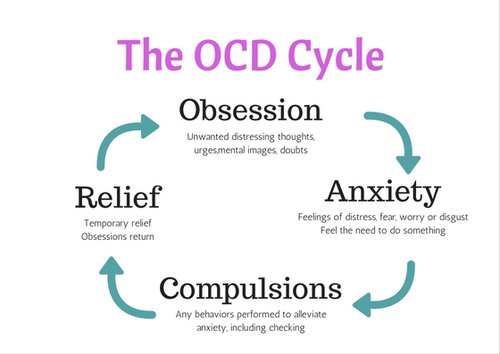Do you like scary movies? If you suffer from OCD, I imagine they may make you uncomfortable. However, the experience of watching horror films can be a useful analogy in understanding OCD as well as how and why Exposure and Response Prevention (ERP) is effective. First, it is important to understand the goals of ERP.
OCD almost always follows the following cycle:
Unfortunately, the word “temporary” is crucial here because when this cycle is completed, obsessions always return and the cycle begins again. Therefore, ERP aims to break this cycle in two places: 1) between Obsessions and Distress and 2) between Rituals/Compulsions and Temporary Relief. Today we are going to focus on how we break the connection between Obsessions and Distress…in other words, how we make obsessions less distressing!
How are Scary Movies and the OCD Cycle similar?
Imagine you are having a movie night. Your responsibilities for the day have been completed and you have the day off tomorrow. The sun has gone down, the popcorn has been popped, and your friend arrives with their movie choice for the night. Dang it! It’s a horror flick. The movie begins and as you are watching, inevitably a scary scene begins. The screen is dark, the sound becomes quiet, and the music slowly starts to build. You can feel the tension rising. You are anticipating the monster will jump out at any minute with a loud “bang!” Right before the scene comes to a climax, you pull the covers over your head and plug your ears. For a moment, the tension inside of you decreases as you feel safe. The climax passes, you wait for the sound of the next scene to begin, and you slowly pull the covers off from over your head to make sure it is safe to watch again. This is what happens when we give in and complete the OCD cycle, except the anticipation of the monster are your obsessions, the associated tension is your distress, pulling the covers over your head and plugging your ears are your compulsions, and the temporary decrease in tension and feelings of safety are your relief.
How Do We Make Obsessions Boring?
Now, I want you to imagine that despite the fear and discomfort, you had decided to keep your eyes locked onto the screen before the scene had started. The tension and anticipation occurred all the same, yet you remained attentive. The climax occurred and you were indeed scared. However, a few minutes after the scene ended, your fear began to subside. Now imagine that you decide to watch that same scene every day for the next thirty days. Day two was scary and uncomfortable as well. Day five was a little easier. Day fifteen started to get a little monotonous and predictable. By day thirty, you are bored. This is how we treat OCD. The journey from day one to day thirty takes place through a process called extinction.
Why it Works
Extinction is the process of allowing your body to acclimate to something you have previously avoided. Think of jumping into a chilly pool. It takes a minute or two for your body to adjust, but despite the initial shock, your body naturally regulates itself and finds comfort. If you remain with your discomfort for long enough to allow extinction to take place, your mind also adjusts. While watching the scary movie, it learns that despite the fear evoked by the scene, you are in the safety of your home and are therefore not in danger. While in the pool, your mind learns that despite the messages it sent you about your inability to tolerate the cold, you can manage the initial discomfort, your body will adjust, and you can be safe in the pool.
The Temporary Discomfort Is Worth It
If you are engaging in ERP therapy, you are likely experiencing distress. However, in addition to the distress you are experiencing because of your obsessions, the battle of trying to avoid your distress is likely impacting your life in ways that are less than ideal. Through ERP, we are going to intentionally and repeatedly evoke the obsessions that are causing you distress while teaching you ways to sit with discomfort long enough for extinction to take place. By learning to sit alongside discomfort and distress, your life will open up to new possibilities and values previously avoided. Most importantly, in return for your hard work, you will experience the freedom to live as YOU decide.

